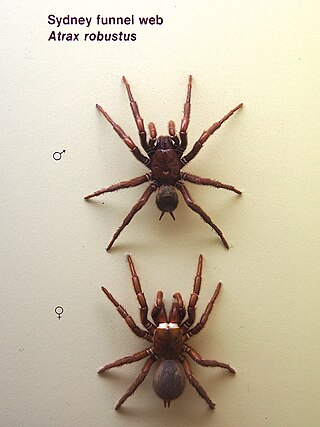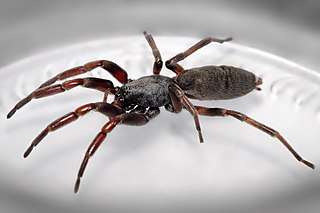

This is a partial list of Australian spiders [1] and harvestmen (Orders Araneae and Opiliones).


This is a partial list of Australian spiders [1] and harvestmen (Orders Araneae and Opiliones).
Family Actinopodidae
Family Araneidae
Family Atracidae
Family Gradungulidae
Family Barychelidae
Family Clubionidae
Family Corinnidae
Family Deinopidae
Family Desidae

Family Dipluridae
Family Dysderidae
Family Gnaphosidae
Family Hersiliidae
Family Hexathelidae
Family Idiopidae
Family Lamponidae
Family Lycosidae
Family Mimetidae
Family Miturgidae
Family Nemesiidae
Family Nicodamidae
Family Oecobiidae
Family Pholcidae
Family Pisauridae
Family Salticidae
Family Scytodidae
Family Sparassidae
Family Stiphidiidae
Family Tetragnathidae
Family Theraphosidae
Family Theridiidae

Family Thomisidae
Family Uloboridae
Family Gagrellidae
Family Phalangiidae
Family Triaenychidae

Atracidae is a family of mygalomorph spiders, commonly known as Australian funnel-web spiders or atracids. It has been included as a subfamily of the Hexathelidae, but is now recognised as a separate family. All members of the family are native to Australia. Atracidae consists of three genera: Atrax, Hadronyche, and Illawarra, comprising 35 species. Some members of the family produce venom that is dangerous to humans, and bites by spiders of six of the species have caused severe injuries to victims. The bites of the Sydney funnel-web spider and northern tree-dwelling funnel-web spider are potentially deadly, but no fatalities have occurred since the introduction of modern first-aid techniques and antivenom.

The Pholcidae are a family of araneomorph spiders. The family contains more than 1,800 individual species of pholcids, including those commonly known as cellar spider, daddy long-legs spider, carpenter spider, daddy long-legger, vibrating spider, gyrating spider, long daddy, and skull spider. The family, first described by Carl Ludwig Koch in 1850, is divided into 94 genera.

Orb-weaver spiders are members of the spider family Araneidae. They are the most common group of builders of spiral wheel-shaped webs often found in gardens, fields, and forests. The English word "orb" can mean "circular", hence the English name of the group. Araneids have eight similar eyes, hairy or spiny legs, and no stridulating organs.

Hadronyche formidabilis, the northern tree-dwelling funnel-web spider, is a medically significant mygalomorph spider found in Queensland and New South Wales. It is also known as the Northern Rivers funnel-web spider or northern funnel-web spider.

The Sydney funnel-web spider is a species of venomous mygalomorph spider native to eastern Australia, usually found within a 100 km (62 mi) radius of Sydney. It is a member of a group of spiders known as Australian funnel-web spiders. Its bite is capable of causing serious illness or death in humans if left untreated.

White-tailed spiders are spiders native to southern and eastern Australia, and so named because of the whitish tips at the end of their abdomens. The body size is up to 18 mm, with a leg-span of 28 mm. Common species are Lampona cylindrata and Lampona murina. Both these species have been introduced into New Zealand.
Spider behavior refers to the range of behaviors and activities performed by spiders. Spiders are air-breathing arthropods that have eight legs and chelicerae with fangs that inject venom. They are the largest order of arachnids and rank seventh in total species diversity among all other groups of organisms which is reflected in their large diversity of behavior.

Argiope protensa, commonly known as the tailed grass spider or teardrop spider, is a species of spider in the orb weaver family, Araneidae. This species is fairly common and widespread in Australasia, but like many spider species, little is known of its ecology, biology, or life history.

The Sydney brown trapdoor spider is a spider in the family Idiopidae, found primarily around Sydney, Australia. It is usually shy and retiring and is often confused with the Sydney funnel-web spider, which is one of the most venomous spiders in the world.

Australia has a number of highly venomous spiders, including the Sydney funnel-web spider, its relatives in the family Hexathelidae, and the redback spider, whose bites can be extremely painful and have historically been linked with deaths in medical records. Most Australian spiders do not have venom that is considered to be dangerously toxic. No deaths caused by spider bites in Australia have been substantiated by a coronial inquest since 1979. There are sensationalised news reports regarding Australian spiders that fail to cite evidence. A Field Guide to Spiders of Australia published by CSIRO Publishing in 2017 featuring around 836 species illustrated with photographs of live animals, around 381 genera and 78 families, introduced significant updates to taxonomy from Ramirez, Wheeler and Dmitrov.

Spiders are air-breathing arthropods that have eight limbs, chelicerae with fangs generally able to inject venom, and spinnerets that extrude silk. They are the largest order of arachnids and rank seventh in total species diversity among all orders of organisms. Spiders are found worldwide on every continent except for Antarctica, and have become established in nearly every land habitat. As of November 2023, 51,673 spider species in 136 families have been recorded by taxonomists. However, there has been debate among scientists about how families should be classified, with over 20 different classifications proposed since 1900.

Hadronyche versuta, the Blue Mountains funnel-web spider, is a venomous mygalomorph spider found in central New South Wales.
Atrax yorkmainorum is a venomous species of Australian funnel-web spider belonging to the Atracidae family and is found in forests in the vicinity of Canberra and south-eastern New South Wales. The genus Atrax was first documented in 1877 and the Atrax yorkmainorum species was first described in 2010.
Illawarra is a monotypic genus of Australian funnel-web spiders containing the single species Illawarra wisharti. It was first described by Michael R. Gray in 2010, and has only been found in the Illawarra region of southern New South Wales. It is a member of the subfamily Atracinae, the Australian funnel-web spiders, a number of whose species produce venom that is dangerous to humans. The generic name comes from the Illawarra region where the spider was found. The species name wisharti honours Graeme Wishart, who collected many mygalomorph spiders in that region.
Arbanitis melancholicus is a species of armoured trap-door spider in the family Idiopidae, and is endemic to New South Wales.

Dr Michael Robert Blair Gray was an arachnologist who specialised in the taxonomy of spiders at the Australian Museum in Sydney with a particular interest in the systematics of Australian funnel-web spiders (Atracidae).